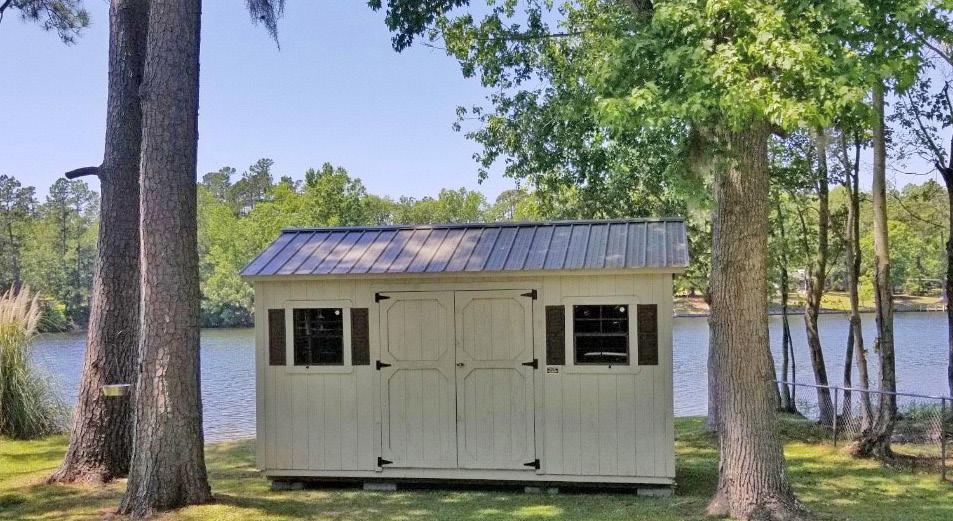A bee-utiful bond
Two Sumter locals form a friendship over beekeeping

Sumter Aquatics Center
20 years of swimming and training with new features coming soon
PLUS: How social media saved a generational farmer's country store

Two Sumter locals form a friendship over beekeeping

20 years of swimming and training with new features coming soon
PLUS: How social media saved a generational farmer's country store


At every stage in life, women have unique healthcare needs. McLeod Women’s Care

Clarendon is pleased to welcome Dr. Katee Wyant as she joins Dr. Monica Ploetzke, Dr. Thomas Key, and Certified Nurse Midwives Tom Chappell, Rebecca Cartledge, Shay Dowdle, and Allison Saran in providing a full range of women’s services from adolescence to menopause, including pregnancy, childbirth, and postpartum care.








PUBLISHER
Vince Johnson EDITOR
Kayla Green
COPY EDITORS
Rhonda Barrick
Melanie Smith
WRITERS
Shelbie Goulding
Alaysha Maple
Ashley Miller
Bruce Mills
PHOTOGRAPHY
Micah Green
Mia Lee
PUBLICATION DESIGN
Micah Green
Janel Strieter
ADVERTISING / GRAPHIC DESIGN
Cary Howard
Janel Strieter
ADVERTISING CONSULTANTS
Karen Cave karen@theitem.com
Devin McDonald devin@theitem.com
Mark Pekuri mark@theitem.com
Oh, summer. The time of year when bees buzz, boats motor, bobbers bob and gardens bloom in the Midlands. All involves getting outside and basking in the sunshine, embracing the Southern heat. That’s the essence this issue of Lakeside captures.

For our avid hunters, 40-year hunter Adam Tweedell lays out what you need to know about bowhunting this season. For gardeners who are looking to go the extra mile in their backyards, two Sumter neighbors provide tips and tricks on starting your very own koi pond to give your garden just the Zen and life it needs. Our frequent lake fishermen can learn the latest trends in the sport or hobby that will make you feel like a pro in no time. Swimmers can feel inspired to become certified lifeguards with Sumter Aquatics Center. There’s also tips on how to outsmart plant-killing pests like squash vine borers. We also met up with two Sumter men whose longtime friendship started with a love for honey. Fourteen years
later, the now 88-year-old and 36-yearold work together in the trade of beekeeping. And Martin Farm Meats shared insight on how their country store got a second chance thanks to family. Owner Samuel Martin feels blessed for his great-granddaughter, whose social media skills made the family business an overnight sensation. We thank you for reading Lakeside, and if you know someone or something you want to see covered in these pages, let us know at newstip@ theitem.com. Happy reading!





















































Florence Food Truck Festival
Be sure to arrive hungry to the Florence Food Truck Festival Friday-Saturday, June 16-17, at the Florence Center, 3300 W. Radio Drive, Florence. From 4 to 10 p.m. Friday and 11 a.m. to 10 p.m. Saturday, enjoy tasty eats and treats, craft brews, domestic beers, live entertainment and more.
South Carolina Senior Sports Classic
Open to anyone age 40 and older, the event will be held Friday-Saturday, June 16-17, at various locations around Florence. Competitions will be offered for both men and women in five year age increments. The State Games showcases teams as well as individuals in events such as basketball, swimming, track and field, golf, tennis, cycling, pickleball and triathlon and less-strenuous events such as bowling, horseshoes, shuffleboard, table tennis, badminton, archery and bocce. In addition to sporting events, there will also be a dinner and celebration of athletes, Bingo, fitness and education classes and more. Visit https://sc.fusesport. com/news/2023-SC-Sports-Classic-EventSchedule-x-16543.html for more information.
Backcountry Brews
Presented by the Sumter County Museum and Sumter Original Brewery, the event will be held from 6 to 8 p.m. on Tuesday, June 13, at 122 N. Washington St. Learn all about beer brewing, past and present, while enjoying beer samples, barbecue and live music. This event is for age 21 and older. Limited tickets available. Register at www. sumtercountymuseum.org or call (803) 7750908.
The Fourth Friday Concert Series
The Fourth Friday Concert Series will provide free concerts from 6:30 to 9 p.m. at 141 N. Main St. in front of the Sumter County
Courthouse as follows: June 23, The Jebb Mac Band; July 28, Elijah Bradford and the Coffee House Music Revue; and Aug. 25, The Footnotes. There will be food trucks/ vendors available from Lisa Ann’s Kitchen, Mi Promesa, Rollin In Da Dough, SO Cool Italian Icee and Sweet Frog. Sertoma will have plenty of cold brews available for sale. The Palmetto Optimist Club will offer free books for the children as well as popcorn for sale. Downtown restaurants will also be open for dine in or take out. Bring your chairs and spend an evening enjoying some music and dancing in the streets.
The event will be held from 10 a.m. to 4 p.m. on Saturday, July 22, at the Sumter County Civic Center, 700 W. Liberty St. This indoor and outdoor event will feature Jeep vendors, a flex ramp, live music, food vendors and the Jeep Show and Shine. Visit https:// krawlinforchrist.wixsite.com/my-site-1 for details or find the event on Facebook.
The Southeastern Piano Festival
The event will be held June 11-17 at the University of South Carolina School of Music. For complete concert schedule, ticket purchasing and more, visit https://www. southeasternpianofestival.com/ .
Reggaetronic Lake Murray Music Festival
A celebration of music and togetherness igniting the soul of Columbia and Lake Murray, the Reggaetronic Lake Murray Music Festival will be held from 10:45 a.m. to 7 p.m. Saturday, June 17, at Spence Island, Lake Murray. Event is accessible by boat only. Proceeds benefit the Shriners Children’s Hospital. Visit https://reggaetronicsc.com/ for tickets or more information.
The event will be held from 1:30 to 9:30 p.m. on Saturday, June 17, at Segra Park, 1640 Freed St., Columbia. The festival will feature live entertainment, food trucks, exhibits, vendors, a bounce house and games. For more information, visit https://www. juneteenthfreedomfest.com/ .
The Dam Boat Run at Lake Murray
An event that will showcase some of the most impressive works of nautical beauty, style and engineering that the world of powerboating has to offer will be held June 23-24. Visit https://www.lakemurraypowerboatrun.com/ to register or for complete schedule details.
The 35th Annual 4th of July Celebration
The event, presented by Lexington Medical Center, will be held Saturday, July 1. Enjoy the patriotic boat parade of decorated boats at Bomb Island beginning at noon. The parade will be viewable from the park sites at the Lake Murray Dam after 12:30 p.m. or by boat. This year’s theme is “Red, White, Blue and You.” The fireworks display will launch at dark (roughly 9:30 p.m.) from Spence Island and Dreher Island. Visit https://www. lakemurraycountry.com/event/4th-of-julycelebration-on-lake-murray-presented-bylexington-medical-center/ .
The Fort Jackson Independence Day Celebration
The event will be held on Saturday, July 1, at Hilton Field. Gates will open at 4 p.m. Celebrate Independence Day with children’s carnival rides, food trucks, live music featuring Blanco Brown with Brooks Herring and fireworks. Free and open to the public.
The Lexington County Peach Festival
The festival will be held on Tuesday, July 4, in Gilbert as follows: 8 a.m.-2:30 p.m., car show at Gilbert Middle School; 9 a.m., art and craft exhibition at Gilbert Community Park on Rikard Circle; 9 a.m.-11 p.m. live entertainment; 9:30 a.m., peach parade begins on Hampton Street near the corner of Harmony Street, turns right on Main
Street, climbs the big hill and ends near Hayes Street at the access road behind Gilbert Elementary School; and 10 p.m., fireworks. For detailed event information, visit http:// lexingtoncountypeachfestival.com/.
The event will be held on Saturday, July 15. This police-escorted cruise will leave from 421 Bush River Road and cruise to the South Carolina Statehouse, 1100 Gervais St. Call (803) 6610802 or visit https://www.corvettesunited. org/.
The run will be held Saturday, Aug. 5, at 2515 Devine St., between King and Queen streets, Columbia. The Ice Cream Youth Run (noncompetitive) will begin at 7:30 p.m., and the 5K Road Race will begin at 7:45 p.m. For registration information and complete details, visit https://www.strictlyrunning.com/hsn/ index.html.
The 3.1-mile run, with obstacles and CrossFitstyle exercises designed to challenge participants of all ages and fitness levels, will be held at 8 a.m. on Saturday, Aug. 20, at 541 Gibson Road, Lexington. Over the past 16 years, the Jailbreak Race Series has raised more than $95,000 to support professional law enforcement services in Lexington County. To sign up to participate or for more information, visit https://tinyurl.com/y8zr99jz
Auto, Bike & Golf Carts Show
The event will be held from 7 a.m. to 3 p.m. on Saturday, June 24, at JC Britton Park, 3057 Raccoon Road, Manning. All vehicles – cars, trucks, motorcycles and golf carts – are welcome. Event will feature food, games and music by DJ Soldier Boy. This is your chance to go for a hot air balloon ride. Pre-register your vehicle and/or purchase your tickets for the hot air balloon at www.monarchstrong.com.
Foodies Food Truck Festival
Featuring the finest food trucks of South Carolina, the event will be held from 11 a.m. to 7 p.m. on Saturday, June 24, at the Clarendon County Dragstrip, 8497 Silver Road, Manning.
3rd-AnnualJuneteenth Celebration
Kershaw County’s 3rd-Annual Juneteenth Celebration will be held 3-8 p.m. Friday, June 16, at the Camden City Arena, 420 Broad St., Camden. Event will include music, poetry, dance, food, vendors and games. For information, contact Dr. A.D. Givens at (803) 549-1323 or dr.ad477@gmail. com. Visit https://www.facebook.com/ JuneteenthCamdenSC .
4th-Annual Walk on Purpose
The event will be held on Saturday, June 24, at Elgin Community Park, 1458 Haigs Creek Drive, Elgin, SC 29045. Registration begins at 8 a.m. Registration fee is a minimum donation of at least $5 worth of food and/or toiletry items. Event will feature food, prizes and a community fund.
2nd-Annual Let Freedom Ring Celebration
The Bethune event will be held 5-10 p.m. Saturday, July 1, at Bethune Memorial Park, 109 College St., Bethune, SC 29009. Event will feature food, music, crafts, a golf cart parade and more. Call Bethune Town Hall at (843) 334-6238 for information.
The event will be held 6 p.m. Friday, July 7, to 9 a.m. Saturday, July 8, at The Nature as Teacher Preserve for Education, 247 Chestnut Ferry Road, Camden, SC 29020. Cost is $114 per family (up to five people) and includes Bojangles breakfast, smores and programming. Enjoy a night hike “owl prowl,” guided stargazing, campfires, smores and more. Families can pitch a tent at the preserve and spend the night learning about nocturnal animals and playing games. Families are required to bring their own tents, sleeping bags and overnight gear. Dress appropriately for the weather, and it is suggested that you wear closed-toe shoes/ hiking shoes and long pants to protect your legs. Bring flashlights as well. The following will be provided: smores sticks and supplies, restroom toiletries (restrooms will be open all night), games, breakfast from Bojangles, guided hikes and stargazing and storytimes. For information, contact Leoncia Cruz at (610) 715-2788 or leoncic@clemson.edu. Visit www. natureasteacher.myportfolio.com/.
The event will be held from 6 to 8 p.m. on Friday, June 16, at 2345 Norway Road, Orangeburg. Yuncle Boudreaux will serve as host featuring Paul Snyder with Travis “TLink” Lincoln as the headliner. For tickets or more information, visit https://tinyurl.com/ mrx2u2cc
Hibachi Heroes
Friday Nights at the Farm will present Hibachi Heroes in concert from 5 to 8 p.m. on Friday, June 30, at Hickory Bluff Berry Farm, 245 Hickory Bluff Lane, Holly Hill.
Saturday-Sunday, June 10-11, South Carolina State Fairgrounds, 1200 Rosewood Drive, Columbia. Show hours: 9 a.m.-5 p.m. Saturday and 10 a.m.-4 p.m. Sunday. Admission is $10 per person, and children age 12 and under admitted free with paid adult. Parking is $5. Visit https://www.scgunshows.com/ . Call (803) 463-9377 or email showdirector@ scgunshows.com.
Saturday-Sunday, June 17-18, Piedmont Interstate Fairgrounds, 575 Fairgrounds Road, Spartanburg. Show hours: 9 a.m.-5 p.m. Saturday and 10 a.m.-4 p.m. Sunday. Admission is $10 per person, and children age 12 and under admitted free with paid adult. Visit www.greatamericanpromotionsllc.com, call (865) 453-0074 or email mwxmarketing@ aol.com.
Saturday-Sunday, June 24-25, Civic Center of Anderson, 3027 Martin Luther King Jr. Blvd., Anderson. Show hours: 9 a.m.-5 p.m. Saturday and 10 a.m.-4 p.m. Sunday. Admission is $10 per person, and children12 and under admitted free with paid adult. Visit www. greatamericanpromotionsllc.com, call (865) 453-0074 or email mwxmarketing@aol.com.
Saturday-Sunday, Aug. 19-20, TD Convention Center, 1 Exposition Drive, Greenville. Show hours: 9 a.m.-5 p.m. Saturday and 10 a.m.-4 p.m. Sunday. Admission is $10 per person or $8 with military identification, children ages 12 and under admitted free with an adult. Visit https://www.scgunshows.com/ . Call (803) 463-9377 or email showdirector@scgunshows. com.































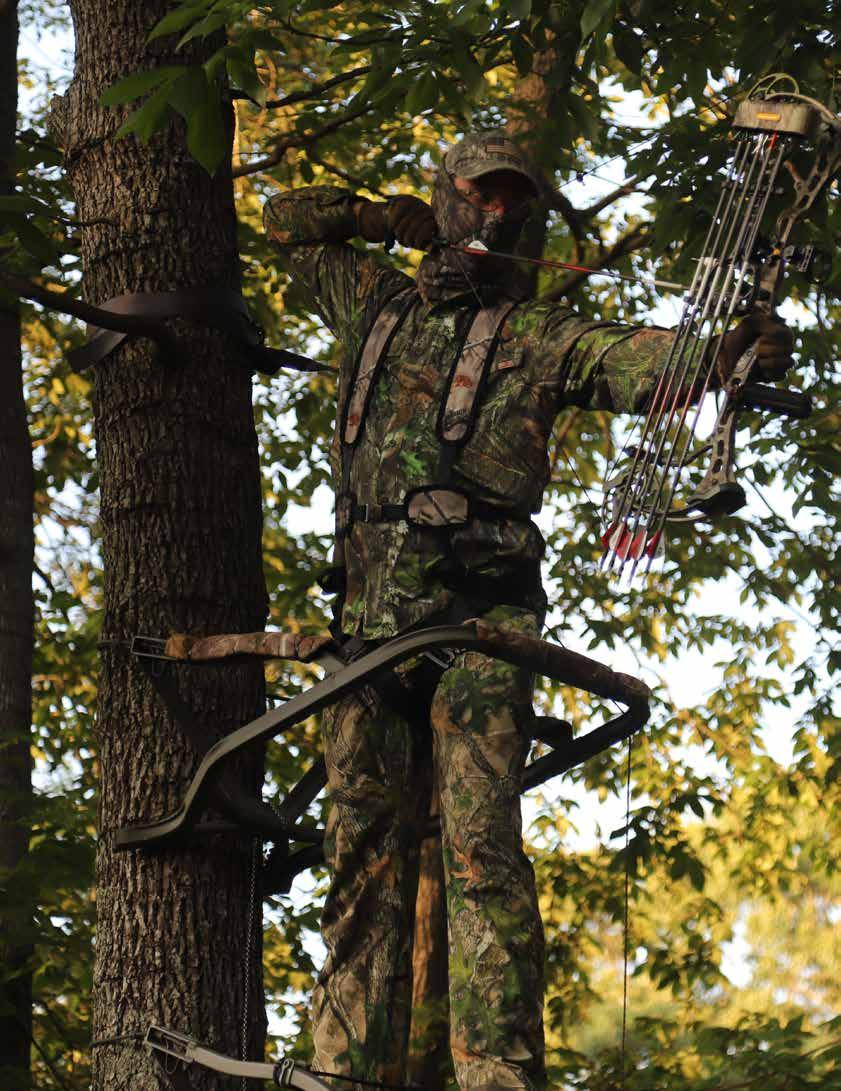
Question from Lakeside: Is bowhunting more difficult than hunting with a rifle?


Adam Tweedell has been shooting for about 40 years, but his daughter is the reason he only started bowhunting 11 years ago. He took the 9-year-old on a turkey hunt, but the shotgun’s kick and recoil were too much for her.
“Lexi said, ‘I am not interested in hunting with a gun, but I want to hunt with a bow,’” Tweedell said. “So, I had to learn how to hunt with a bow in order to teach her.”
After some homework and research, the Sumterite, who spent about 25 years in the Army, which helped build and refine his skill set, found a bow appropriate for him and purchased it.
“Over time, I learned how to use
it,” he said. “I became successful at it and realized that I do enjoy it.”
In less than six months, Tweedell was on his first deer hunt with a bow.
He recently spent some time with Lakeside discussing the craft and the differences between bowhunting and hunting with a rifle. We also talked about the sport with Summerton’s Scott Dault, who owns and operates Crossroads Archery shop in Clarendon County. Dault is wellknown for his archery exploits that include hunting bear in Canada and bowhunting on African wildlife safaris.
“Yes. Take deer hunting for instance.
Deer hunting with a rifle, I can shoot a deer 300 yards away. He would have no clue that I am even in the world. Now, you have to consider wind, human scent and noise, of course. But, with a bow, you have to consider those factors exponentially more because it’s preferred that you have that deer 40 yards or less with a bow.
You definitely have to hone your skills and think a lot more. You really have to learn the animals a lot more if you are going to bow hunt, specifically deer, since the range is much closer.
For a gun hunter, you barely have to move and you can shoot. With a bow, you have to be able to draw at some point. So, you have to watch that animal’s behavior. You must really concentrate, be patient, and things are very different.
I enjoy the challenge with archery hunting to get that animal close enough.”
There are traditional bows, compound bows and crossbows and archers in all three groups. Traditional archers are the smallest group now but once were the biggest group.
Scott Dault said the modern compound bow first came on the market in the mid- to late 1970s.
They are now the most popular in bowhunting, and compound archers use bow sights and a rear peep sight for aiming. This style also allows for any number of accessories to include stabilizers, levels, release aids and more.
A crossbow has sights that are similar to a rifle. Tweedell said it is the bow to start youth with in the sport.
Benefits include that it is “extra still” and “accuracy,” he said.
“If you are familiar with shooting a rifle, then shooting a crossbow is very similar. The sight on a crossbow is a lot like a rifle’s sights. Crossbows are good for archers who cannot draw a compound bow, and they are good for youth.
Compound bows and crossbows are more popular than traditional bows today for the ease of use. You will have a lot of archers that cross the line though. There are a lot of compound bowhunters who will use traditional equipment as well as crossbows from time to time. I hunt with a crossbow from time to time because it is fun, and I enjoy it.”
Lakeside: What is the typical distance for bowhunting?
Most archery hunting is limited to 30 to 40 yards,
possibly 50 yards at the very most.
“My furthest shot on a deer was about 45 yards, and all the conditions were just right. If you are out in a tree stand overlooking a corn field and it is high wind, you definitely don’t want to try to launch an arrow 60 or 70 yards. There are plenty of archers out there who can shoot out to 100 yards with a compound bow, and a crossbow can shoot out to 100 yards, but you must take the ethics into mind as well, right?
Is that projectile still carrying enough energy to do what it is intended to do? When you fire a bullet, after an extended period of time, it loses energy and it will drop. If you have a long enough open area and you shoot it flat, it is going to eventually hit dirt. Same thing with a bow. It is just going to lose that energy a lot faster.
The ethics come into play where no hunter wants to wound an animal and not recover it. A good, ethical hunter wants to dispatch that animal as quickly as possible. So, you don’t want to go launching arrows at a deer 100 yards out.
Just because a crossbow can shoot 100 yards doesn’t mean you hunt at 100 yards.”
He said he can practice in his backyard at about 50 yards with a target.
“I will practice at that range because if I am good at that range, then I am even better at 30 yards. But I won’t shoot an animal at 50 yards. An ideal for range for me for both turkey and deer is inside 30 yards.”
Lakeside: What do you hunt with a bow?
“Archery-specific hunting for me is turkey, deer and pigs (or hogs – they are synonymous). I love to eat all three. More often than not, I am not going to shoot it if I am not going to eat it unless it is a threat or predator.
I use a shotgun also with deer, dove, ducks, geese and migratory birds. I do shoot squirrels also to eat.”
Lakeside: What was the learning process for you?
“I had been hunting for 30 years when I started archery, and especially with YouTube today you can do a lot of that work yourself. But there are archery shops in Summerton (Crossroads Archery), Columbia and Florence.
All in all, if you take care of your bow, you really don’t need a lot done with it. Wax your string good. Take care of it.
Archery equipment can be extremely expensive. You can go out and buy a $1,200 bow and put $1,000 worth of attachments to it before you even get to the arrows. Or, like I did, I looked online and bought an already-assembled bow for about $350 in 2012. Then I bought a handful of arrows for like $40 or $50, got some broadheads – that was another $40 or $50.
But, I still have two of those original arrows that I bought when I started, and I still hunt with the same bow that I originally bought. Some people will buy a new bow every year, but I cannot do
that. Every once in a while, you have got to change the string on it because after shooting for so long and weather and just time, the string gets old and it starts to fray, and you don’t want to shoot it because it gets unsafe.”
Lakeside: How can youth get started with bowhunting, and what is the benefit?
“Local organizations like Scouts, 4-H, Cross Trail Outfitters (CTO) Youth Hunting and Fishing Club is a group that I am associated with in Sumter, or a school-based archery team or sporting clays team at the high school level are all options.
The benefit that the kids get is that sense of learning and accomplishment because you get immediate feedback – you have a target 20, 30, 40 yards away from you and you have learned how to use this equipment.
You get better quickly, and you get immediate results because you can see exactly what you are doing.
I taught a youth archery class for one of the local churches once, and the parents were all on board for it. I went there one evening and gave them an introductory class to archery equipment, safety and things like that. Then, we took them out to a friend’s house and set up targets and little balloons because kids love popping balloons. So, we put little balloons on targets, and they had to shoot it with a bow and arrow. It was great.
Even if they don’t hunt with it, target shooting is huge as a confidence builder and provides a sense

of accomplishment for the kids.

I know a young boy; he is not into hunting, but he loves to shoot the crossbow. He’s very good at it. He doesn’t care for the guns. It is not loud like guns, but he loves to shoot that crossbow.”







Lakeside: What is a good first animal for kids to hunt?


A good first animal to hunt with a bow is a deer.
Typically, at Cross Trail Outfitters, we will start the boys on their very first hunts with squirrels.
Not archery, but we will start them with a small shotgun, and we will shoot squirrels. Because if they have never killed an animal, the first time can be shocking; so, we will shoot squirrels first and graduate them up from that.
But once we get them into deer, we will let them shoot rifles first with deer hunting, and then we will graduate them to archery equipment. Since you have got to get that animal so much closer to you, it’s kind of graduation for them from rifle. We have found that it works.
I am sure there are plenty of people out there who only bow hunt, and they take their kids bowhunting. I know there is a YouTube channel on that. All of them are purists when it comes to archery equipment, and a lot of the pro staff take their kids out and put them on crossbows first. And then once they get good with the crossbows, then they will graduate them to a compound bow. So, there is a progression there as well. But for us, at CTO, we start them off with a rifle and then graduate them to archery equipment.”

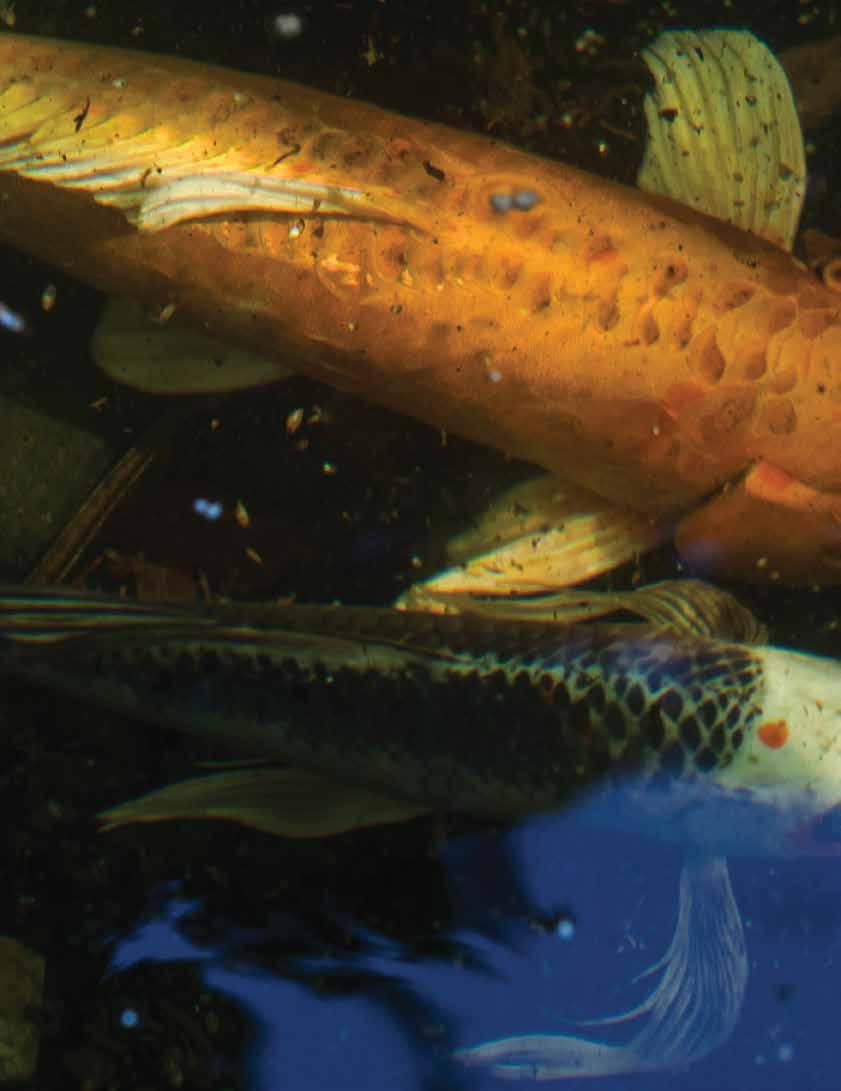
Koi ponds and water gardening might seem like a challenging hobby, but it’s a piece of cake for outdoor enthusiasts who strive to keep their hands working while also looking for ways to improve their local surroundings.
Two self-taught Chestnut Street neighbors have been doing just that for over a decade. They mostly have fun, but it’s gotten a little competitive along the way.
Heidi Adler, an art teacher at Sumter High School, spends afternoons in her backyard either tending to the animals or her garden.
“I like to build, and I really enjoy the outside, and I really just enjoy fish. It’s really nice to come home after anything and sit and listen to the water,” she said.
Billy Welborn, who lives just a few houses down from Adler,
spends his afternoons the same way after working with animals all day at the Sumter Petco.
Welborn who has worked with fish for a long time, started with a small goldfish pond about 23-24 years ago. He didn’t start specializing in koi habitats until Adler got him looking to go big or keep his home less colorful.
Both Adler and Welborn have massive backyards in the heart of historic downtown Sumter. Their koi ponds are hidden away, tucked against the house or buried under unique plants. It’s an impressive sight, and it took a lot of work to get there.
Adler started 12 years ago by digging a pond under her patio. Now, that pond has expanded into two connecting ponds that hold more than six 12-inch kois, an above-ground stock tank that

holds about 30 3-inch 1- to 2-year-old koi fish and a 5-gallon tank inside her house with over 30 newborn koi that are less than a centimeter in length.

“This has been years to get where I’m at now, but typically the ponds, they take a couple months if I’m working by myself, digging them out and putting the plastic down inside it and building the edges,” Adler said. “It’s all great work.”
Her large koi are the same fish she started with 12 years ago; koi can live to be 30 years old, Adler said. They start laying eggs around age 7.
She didn’t mean to pay attention to the eggs and raise baby koi. Adler happened to notice them one day and expanded her project beyond her original plan.
“I didn’t know much about it, and one day I was out here one morning drinking my coffee and they were fluttering up against the sides throwing themselves against the side of the pond,” she said. “The male actually helps the female by pushing against her to release the eggs, and he’s fertilizing the eggs.”
The eggs are like little grains of sand that stick to the edges of the pond. Adler will find them and pick them off. She takes them inside to hatch and grow for a couple of months until they’re large enough to go outside.
In doing this, she has ended up producing more koi than she has room for, so she started giving them away.
“A lot of his are my offspring,” Adler said about Welborn’s pond.
Thus, the neighborly competition was born.
Once Adler built her koi pond, Welborn expanded his. That only drove

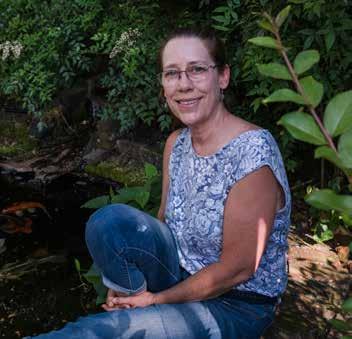


















her to expand. Then he expanded again. Then it was her turn… she extended her pond last summer.
“Now mine’s bigger, but until last year his was bigger,” Adler said.
Instead of Welborn expanding next, he installed a motion sensor sprinkler to scare off predators, like great blue herons, which hunt in both their ponds. Now, Adler wants one.
“This is what’s been going back and forth,” she said. “We’re very, very good friends, so we share ideas and he helps me a lot.”
Both continue to have thriving koi ponds and want to share best practices for those looking to build their very own koi pond.
“Start out small with something you can handle, and as you get comfortable you can go bigger,” Adler said.
There are small plastic ponds people can use to start, but both Adler and Welborn suggest people dig out a deeper pond like they did to allow the koi to grow; they can get up to 15 inches in length.
“Digging a hole, it can be really tricky to get your filtration system set up right,” Adler said. “Mine are actually a little bit high, and so this year I’m going to try to drop the water a little bit and get them a little bit lower.”
Koi need a lot of oxygen, so if you’re going to have them, especially in the summer when the oxygen is not as prevalent because of how warm the water gets, running water is essential, Adler said. A good filtration system or flow of water keeps oxygen in the water.


“The water is a big deal. City water, it’s a little difficult on them. You can add a little bit at a time, but I put well in last year, so it’s really nice,” Adler said. “Well water can go right in. It’s nice and cool, and the fish absolutely love that fresh water. You can only add so much city water at a time because otherwise it will be toxic to the fish.”
At one point before Adler got her own well, she had an emergency where her ponds were in dire need of well water. But Welborn lives five houses down the street.
“We hooked up hoses from here all the way down the street,” Welborn said with a laugh. “We had hoses all the way down. All of ours and the neighbors.”
“I had a lot harder time until I got a well,” Adler said, exuding relief.
Both said it’s ideal to build your pond in the shade and under heavy foliage, but you then will want a filtration system that keeps things moving and filters out leaves to keep the water clean.
Welborn suggested installing two pumps to run in case one fails; both Adler and Welborn have two running in their ponds.
Welborn’s biggest priority for folks digging out a koi pond is to have a great liner.
“Billy found the firestone lining, and it is fantastic,” Adler said.
“It’s worth the cost,” Welborn added.

































































The Santee Cooper lakes have been home to anglers from all over South Carolina and the United States for decades. The upper and lower lakes are known for having some of the biggest bass across the nation, and these lakes have seen growth over the years.
Lake Marion and Lake Moultrie have been a favorite spot for fishing tournaments in Clarendon County, and professionals from all over come every season to compete in the King Kat, Bassmaster, Bassmaster Elite Series and attend the Striped Bass Festival.
“Fishing is certainly a staple here in Clarendon County,” said Jesse Surette, the county's director of tourism.
Surette said while largemouth bass get the most recognition, there are plenty of other fish in the lakes that can’t be counted out – catfish, striped bass and crappie.
“They round out the ‘Mount Rushmore’ of fishing on the lakes, and each has their own unique draw,” he said.
Surette said the weeklong Bassmaster Elite Series tournament alone brings in over $1 million from anglers’ hotel stays, food and filling up on gas as well as locals who attend the event spending money in town who attend the event.
With many events surrounding fishing in Clarendon County, he said he thinks it is a multimillion-dollar revenue boost from fishing alone.
“In the 20 weeks across the springtime, we bring in over 1,000 to 1,500 boaters and anglers, from the local aspect to across the nation, a mix of professionals,” Surette said.
Levi Kaczka, coordinator for region IV fisheries at the South Carolina Department of Natural Resources, said they have seen a 15% increase in freshwater license sales following the pandemic, but they can’t pinpoint where in the state that increase has happened.
Lake Marion is over 110,000 acres, making it the largest lake in the state. When you look at Moultrie and Marion side by side as the Santee Cooper Lakes, visitors and anglers have over 170,000
acres of water to explore, fish and boat.
“Having a resource like that right in our backyard truly makes this area unique,” Surette said.
Spring is the busiest and most popular time of the year for fishing, especially in the few weeks of April when everything is at “its peak.”
“The warmer weather combines with the spawning season for bass to make for prime lake conditions,” Surette said.
Clarendon County over the years has hosted big tournaments in competitive bass fishing. It has hosted the Bassmaster Elite Series for four years and the Major League Fishing’s Toyota Series Southern Region, and the area was even picked up in the kayak bass fishing scene through organizations like Hobie and Queen City Kayak Bass Fishing out of Charlotte, North Carolina.
The Bass Anglers Sportsman Society releases a yearly ranking of the top 100 bass fishing lakes in the United States. Over the last several years, the Santee Cooper Lakes have had a spot in that ranking, being top 10 in 2022 and named the best in the Southeast.
“In the Bassmaster Elite Series competition, the Santee Cooper Lakes rank third all-time in century belts, which is achieved when an angler catches over 100 pounds of bass during a four-day tournament,” Surette said.
He said in the wake of the COVID-19 pandemic, outdoor recreation really made a huge impact in the area.
“More and more people began to explore the sport and pastime of fishing, and having one of the best lakes in the nation definitely came to our advantage,” Surette said.
He said as more organizations and trails develop for fishing, more people will want to test out the best lakes at the best time.
“We plan to see even more growth for all of our fishing competitions and events in Clarendon County,” Surette said. “Fishing is a popular sport here, and I don’t think it is going anywhere anytime soon.”












































It has always been my dream to help people in the community. Being here every day at Tanners allows me to send people to work in the morning and home in the evening with a smile on their face.

I very much appreciate my customers and employees because without them I wouldn’t have any of this or be able to serve the community. You all make Tanners the Best of Clarendon.

Also voted 9 years in a row for Best of Sumter







“I think being so young and having all of the certifications that it will help inspire a lot of people to strive and push toward their goals.”
-Eriyonna Walcott
For 20 years, Sumterites have had a place to make friends, get great tan lines and have a blast in the summer at the Sumter Aquatics Center.
The aquatics center was built in 2003 and today hosts programs that vary from swim lessons and teams to lifeguard training and summer camps.
According to the City of Sumter, the center meets requirements for competition swim meets and is equipped with six swim lanes, an electronic timer and touch pads, diving blocks, a recently built lazy river, open tube slide for all ages and wade pool with beach entrance and fountain.
The Sumter Aquatics hosts over 20,000 swimmers, splashing around and playing mermaids each summer.
And they only hope to get bigger following their 20-year anniversary.
Grayce Howard, who is the aquatics director and an American Red Cross instructor, said she has never been able to escape the water.
“I love safety. I have been an aquatic director before, and I have always been in the aquatics world. I can’t seem to escape it,” she said, laughing.
For the 20-year anniversary, the aquatics center has big
plans.
“We will be resurfacing the pool, replacing our waterslide with a brandnew slide, we are going to replace our water feature in the shallow end with a fun new water feature for kids and infants, and we are also going to be replacing our diving blocks,” Howard said. “We are going all out for our 20year anniversary.”
always looking to bring in adults that are interested and college-age students,” Howard said.
Some of the lifeguards come back to get recertified at the center and continue to work. Some of the lifeguards even compete in swimming competitions.
McKenzie DuBose is in her third year of being a lifeguard at the center and is currently the head lifeguard. She attends classes so she can play the victim for the students and help teach if needed.
“I kind of float around, no pun intended,” she said, laughing.
DuBose has always been one with the water. Since she was a little girl, she has always been swimming. When she turned 16, someone called her to see if she wanted a job at the aquatics center.
“I used to swim with Palmetto Aquatics in Columbia. Now they have disbanded, but I am trying to see about competitive again,” she said.
DuBose is planning on attending the University of South Carolina in Columbia and may try being a lifeguard at the school.
There is no set time when these things will be done, but until then, the pool will be available to be splashed around in.
Before the pools open, the center is training lifeguards, and some go on to work at the center for the summer.
“This is one of our first years since COVID-19 that we are fully staffed; however, we are

Since the center is looking to bring in more people, DuBose has three reasons to reel people into becoming a lifeguard.


“You get paid to sit by a pool, get a great tan and make a lot of friends,” DuBose said.
Although it can be a lot of fun, she said training and being a lifeguard has its pros and cons.
“Musculoskeletal injury, back valve resuscitation,” DuBose said. “Those can be complicated terms.”
Words by Ashley Miller | Photos by Mia LeeOn the other hand, being a lifeguard has its own hard parts, she said. “It’s the responsibility. You have this huge responsibility that I am glad I have, but it can weigh on you,” she said.
DuBose has had to use her training before and said, “When you’re in it, you’re in it.”
While DuBose and Howard have had years of experience in the water, another local lifeguard just started swimming a little under a year ago.

“I am really proud of how far she has come in swimming,” Howard said. Eriyonna Walcott wants to go into the United States Coast Guard, following in the footsteps of her uncle.

“
“We are ready for this summer and can’t wait to see the kids splashing and having fun, while also keeping safety in mind.”
“I figured if I wanted to go into the Coast Guard, swimming and the training would come in handy,” Walcott said.
She said she can take what she learns in the lifeguard training, like CPR, and use it in tough situations.
“I think being so young and having all of the certifications that it will help inspire a lot of people to strive and push toward their goals,” she said.
Walcott said being a lifeguard or just on a swim team, she can get into her head and doubt her capabilities.
“You keep pushing through when it’s tough. Remember, you got this,” she said.
For 20 years, the Sumter Aquatics Center has served lifeguards of all ages and the staff with a goal to bring in a wider age range of people.




“We are ready for this summer and can’t wait to see the kids splashing and having fun,” Howard said, “while also keeping safety in mind.”
For more information about the center visit sumtersc.gov/aquatics or call (803) 774-3998.











































 Words by Shelbie Goulding | Photos by Mia Lee
Words by Shelbie Goulding | Photos by Mia Lee
Two Sumter men share common interest for beekeeping, honey collecting
Pulling up a worn-out jumpsuit, spotted with markings and patches of discolored shades, it carried years of hard, meticulous work. What was originally pure white grew covered in dirt from fields, scratches from tree branches, minuscule pricks and sweet nectar.
Beekeeping is a challenging, time-consuming task with benefits. Not only does it make for better gardening and creating a healthier ecosystem, but bees also make medicinal and nutritional uses for human consumption.
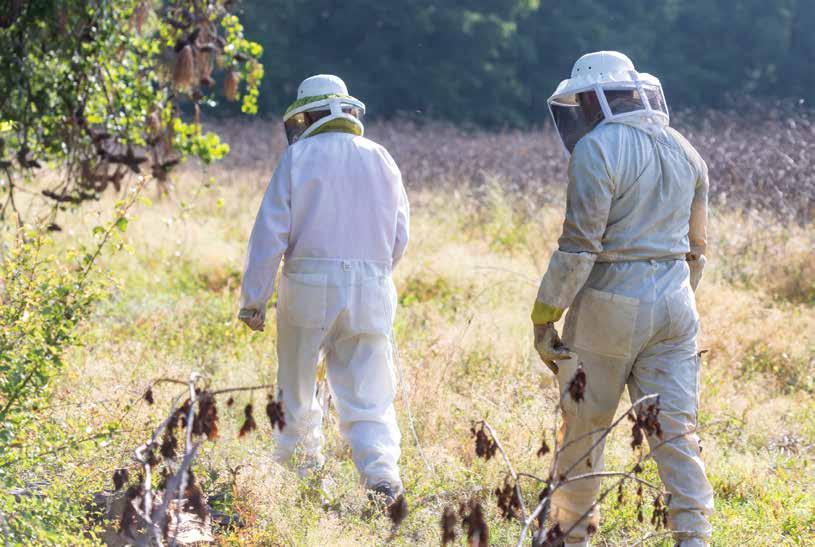
For two Sumter men, they’re in the business out of a common interest for the peaceful work and, of course, honey.
Michael Baier and Leverne Newman come from two different worlds. Baier, a 36-year-old director of orchestras at Alice Drive Middle School, and Newman, an 88-year-old retired furniture store owner. How the two came together was out of curiosity.
“When I first moved to Sumter, one of my other friends, he did a little beekeeping, and I was curious. So, I found Leverne,” Baier said. “He got me started, and I said, ‘Hey, do you need some help in the field and working?’ and he said sure. I didn’t know what I was getting myself into.”
Newman has been a beekeeper since he was 8 years old. He started his first hive after catching his own swarm when walking home from school. He called his uncle for help, and his newfound hobby
began.
“My great uncle kept bees,” he said. “He lived right across the street, and I helped.”
It was 14 years ago when Baier and Newman met, and the pair have never been closer. They grew to being more than a mentor and mentee.
“We’re good partners, I’m telling you right now,” Newman said.
“We are beekeepers, not on the commercial level but on the advanced hobby level,” Baier said.
Veils overhead, the pair made their way back to Newman’s 10-plus hives early on a May morning. Newman with gloves in hand, and Baier with a lit smoker and scraper.
Together, they tackled a few hives, which were old wooden boxes stacked on top of one another nestled against a tree line by a wide-open field. Baier would smoke the bottom of the stack, the entrance and exit for the working bees. Newman worked from the top, removing the cap and each layer of the hive, which held capped and brood combs.
“You go through your hives once every two weeks. If you’ve only got one or two hives, it’ll take you maybe 35-45 minutes, maybe at the most to get through every two weeks. The harvest takes a while,” Baier said. “I just did one with all of his hives. I think we got 14 supers total full.”
A super is referred to as the top box of the beehive, above the brood chamber where eggs,
larvae and pupae are stored. The super is where the bees store honey. It’s ready for harvest once it’s capped, or when the bees seal the honey with wax.
“This one’s full of honey,” Newman said.
Lightly dipping a finger into the capped comb, it collapsed with the slightest pressure to reveal a golden ooze. Sticky to the touch, liquid gold dripped to the tongue, immediately triggering the taste buds to dance.
It was sweet, and not your everyday caked in sugar sweet. It was natural, allowing the bees' nectar to release its essential oils, nutrients and flavor to the senses.
A good year is when they can harvest honey two or three times from a hive, Baier said. Their most recent harvest was a big one. Newman’s hives filled about five gallons.
“It took me all day,” Baier said, assisting Newman. “It takes a while.”
On average, a beekeeper can jar 20 quarts from one hive. Newman has about 30,000 honey bees work one hive, according to Baier.
“Let me show you what bees are good for,” Newman said with a grin, leading the way to his storage space.
Inside, quarts of honey were filled to the brim. Some golden and others dark from different pollen sources. Newman said the pollen matters in color and taste. Most of his plants were wild flowers in
the field and between fruit trees. The bees also collect from an apple, peach and pomegranate tree he planted on his property.

Back when cucumber farming was big in the tricounty region, Newman served farmers by planting hives for their crops. At one point, Newman had about 250 hives he worked; that’s about 7,500,000 honeybees buzzing around the region.
Today, he sticks with his own hives and makes his Newman Bee Supply honey. Baier has about three hives at his home.
Beekeeping is time-consuming but steady. Newman and Baier only go through the hives once every week or couple of weeks just to make sure it’s running orderly.


As Baier checked each frame with Newman, hundreds of bees swarmed the brood chamber. Newman looked at the swarm combs with an idea sparking.
“You know what I’d like to do,” Newman said.
“Oh, I know what you’re going to say,” Baier replied. “You want to split this one.”
“Pull that one out of there. You’ve got a lot of drone eggs in there,” Newman said.
Drone eggs are the male honeybees who do not collect pollen or gather nectar. Their only role is to mate with the queen.
Baier said they didn’t really care for the drone eggs, but they are good for splitting the hives when a queen bee lays an egg in a queen cup, or nest for a future queen egg.
Newman was determined to put the drone eggs in a different hive, and the one other hive he had in mind, Baier talked him out of it.
With more than a decade working together, the two still butt heads. Newman, with more experience and a multi-family generation routine, and Baier, who learned from Newman and selftaught using modern tricks on the web. However, they always end up helping and teaching one another.
“He’ll say don’t do that,” Baier said, “and I’ll say I’m going to do this, and he’ll disagree, but in the end, it’s one of those things. Every beekeeper has their secret sauce.”
Although both initially got started for the honey, Newman and Baier have grown to love nurturing the bees.
“The best time is when they all come back from the field,” Baier said. “They all decide they don’t want to stop foraging, they all come back at one time and pile in.”
Newman is always sitting and watching them fly back in from the fields, mostly because he hopes
“He got me started, and I said, ‘Hey, do you need some help in the field and working?’ ... I didn’t know what I was getting myself into.”
they come back, he joked. However, it’s a peaceful sight as the sun begins to set.
“It’s been a joy of my life,” Newman said.
“For me, just seeing the honey and getting that extra honey and jarring it, that’s a lot of fun,” Baier said. “Now, I’ve been doing it for a while, actually not for the honey. I just enjoy the bees. It’s kind of calming just watching them come in and out. I’ve got them lined on the back fence of my yard.” Both encouraged others to get involved. The honey is better than what’s in the store, Newman preached. Baier said store-bought honey has the pollen strained out, which holds “the good stuff” and all the nutrients, so it becomes strictly sugar and denaturized.
“Buying from the store, you’re not getting what it is,” Baier said.
Baier found Newman with a simple word of mouth and search for a local beekeeper when first getting started, and he suggested those interested do the same or even go through the Sumter County Beekeepers Association or South Carolina Beekeepers Association to find an area beekeeper for guidance. Baier said YouTube has also been a big help.
“As for like space for what you need, you really don’t need much. As long as you’re not walking in front of that hive within 5-10 feet, they’re not going to bother you. You can stick it in the back corner of your yard,” Baier said. “They don’t bother my neighbors.”
“It’s just a lot of fun,” both Baier and Newman agreed. “And some people try it and don’t like it,” Newman added, “but there’s lots of them who do.”
Reflecting on the past 14 years, Baier said it’s been a whirlwind experience. It’s been hard work, but it’s always fun.
“He’s been a good partner and beekeeper,” Newman said, patting Baier on the knee.
“He’s got the best honey though. You know it comes with experience,” Baier said.
For information or tips on how to get started as a beekeeper, email michael.baier@sumterschools.net.


To get some of Newman’s “Pure Honey,” contact Newman Bee Supply at (803) 468-3700.
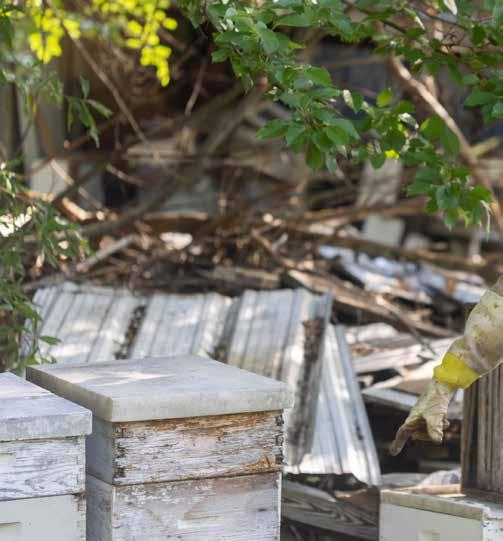


















































You’ve heard of Old McDonald. Now, mee(a)t Samuel Martin. As the owner of Martin Farm Meats, Martin was on the verge of closing his beloved country store following the passing of his wife. His social media-savvy greatgranddaughter, Zakaya Butler, couldn’t let that happen.
With a one-minute video and a heartwarming caption, the 23-yearold turned her grandfather and his store into a social media sensation nearly overnight.
Born and raised in rural Sumter, Martin began farming at a young age, following in the footsteps of his father. Raised on the acres of land to the left
of Westbury Mill Road, he built his current home in the pasture across the road and began raising hogs and cows of his own. While employed at DuPont, he would unwind from his 9-to-5 by spending time with his animals and processing meat.
But after 31 years, he felt it was time for a change.
“I've always believed that I can get up and do my own thing the same way I go and do the other thing,” he said. “I wanna do something for myself, and so that’s what got me into the meat business.”
Located at 940 Westbury Mill Road, right next door to his home, Martin built his own storage room and

freezer to house his meats before they’re cut and packaged to sell, all by hand. Pork chops, ribs, beef, sausages, ox tails – just about any meat you can think of sits stocked on its shelves. He also farms an array of vegetables and other crops like soybeans and peanuts. Making money is the name of the game for Martin, and being able to provide for his family was the gracious reward. Producing fresh quality meat for his community came easy, as it was something he loved to do and allowed him more time to be at home.
Though his days varied between trips to the slaughterhouse and filling orders of various sizes, he always made time for the animals. He’d spend his mornings, afternoons and
pigs and cows. He would talk to them, ask how they’re doing, maybe even ask about their day. No response was given except for the occasional snort and squeal, but he did it to show he cared.

Other days, he’d visit to make sure they
were earning their keep by producing a litter of no more than 10 and no less than six. He joked about his standards, laughing fondly as he said, “My wife used to tell me I was hard on the hog.”
Martin had big dreams for his business, ones that included his wife. Unfortunately, he would put them on hold after she passed in November 2022.
“We had plans to open up and grow bigger business anyway for the meat business, but the good Lord took her, so that changed my mind,” he said. “Slowed me down from where I wanted to go and I said, ‘Well, since I don't have any extra help, I better maintain where I'm at.’”
But his great-granddaughter saw more for his little country store. On April 5, Butler posted a video to her personal TikTok account as a way to get the word out about Sumter’s hidden treasure of quality meats. The video took viewers on a tour of Martin’s land, introduced them to his animals and showcased his store and the Grade A meat neatly stacked in its refrigerator. Written in the caption was a message to viewers to “please stop by and support us” as she wanted to “keep this running.”

Over the course of nearly 48 hours, her lastditch effort to keep the store open went viral – earning hundreds of thousands of views; the video currently sits at over 780,000 views. The minute-long video was shared across multiple social media platforms, and soon, everyone everywhere wanted a piece of Martin Farm Meats.

“Set up online ordering & overnight shipping ASAP! Love from Texas”
“I’m coming to buy from Georgia. What are your store hours?”
“Do y’all ship? I need about 5 packs of oxtails.”
“I’m in Sumter. I’m posting this on my Facebook…be ready [because] my social media followers be ready to purchase..”
“Purchase” would be an understatement. Since going viral on social media, Martin said he can barely keep products on the shelf or in the freezers, selling out of bacon and sausage most of the time. The increase in clientele pushed the duo to create official business
hours of 9 a.m. to 7 p.m. Monday, Tuesday, Thursday and Friday; 9 a.m. to 5 p.m. on Saturdays; and closed on Wednesdays and Sundays. But with meat this fresh and fairly priced, customers – regulars and newcomers alike – stop by even on off days looking to get their hands on quality meat, and, sometimes, Martin just doesn’t have the heart to tell them no.

“I hate a person who come and say I don't have that; that bugs me. I like to have it so you can say how much you want,” he said. “For the last couple of weeks, I had some people who I don't even know nothing about just come in and say ‘I want to buy this, I wanna buy that.’ So that's why I say thank you to my great-granddaughter – I have to give her praise for that.”
Butler handles the bulk of the social media management for the business, mostly through Facebook and TikTok – the rest is left up to customers who share their experiences of Martin's service and the Grade A taste of his products. Social media opened Martin’s mind to avenues he didn’t know existed and certainly didn’t know would change the trajectory of his business and his life. The boom of his business shocked him, but not as much as the realization that his great-granddaughter has a true interest in the nitty-gritty side of the business.
“She asked me, she said, ‘Granddaddy, get me a pair of boots.’ I said, ‘What you gonna do with boots baby?’ ‘Granddaddy, I got to go in the hog pen.’ I know I don’t have it set with mud like in the old days, but you got to walk out in the pasture and you’re going to get dirty, but she don’t mind getting dirty,” he said, his tone and his eyebrow lifting in surprise. “I just was glad to have her. I'm hoping that she sticks with me for a while to get things really going. It opened me up and taught me about running from place to place to keep different things in here.”

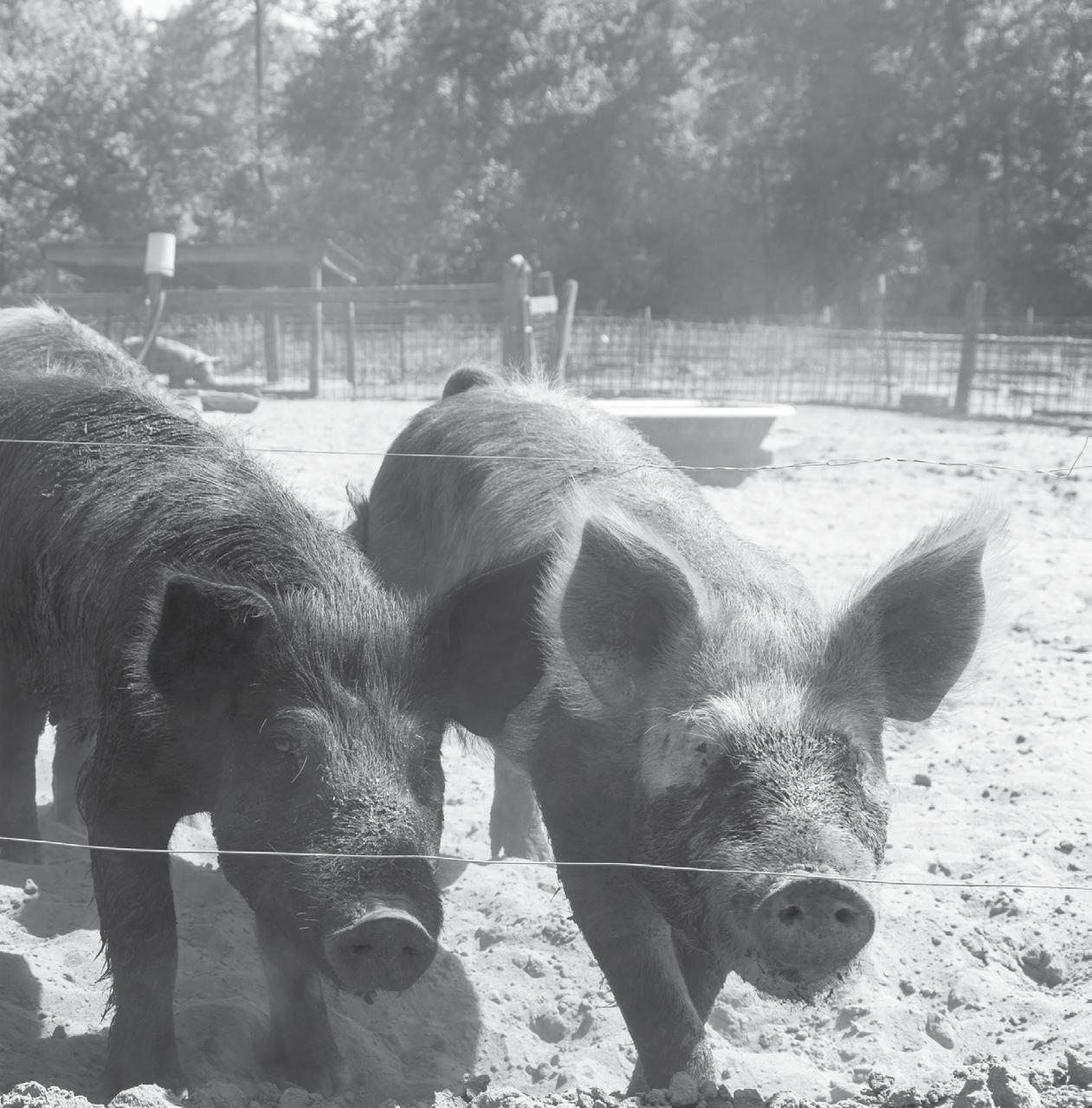
Martin thinks fondly of his great-granddaughter. In the way the faint smile on his face makes an appearance any time he mentions her to the warm way he speaks about her willingness, her attention to detail and her love for animals and store – she didn’t just save thebusiness, but saved him as well.
Surrounded by the brick walls he built by hand, Martin knows that one day he’s going to have to hang up his – surprisingly clean – brown boots. His only hope is that his great-granddaughter will be well-prepared by then to take the reins.
“She's got a lot to learn,” he said. “If she sticks around, she’ll probably, maybe one day, when I feel like I can go, I hope she’ll be able to maintain and keep going. You have to get up and when you don’t wanna go, you’ll have to go; that’s the name of the business.”
Check





























































Let’s (hopefully) outsmart the dreaded

My second method of fighting back is a trap. The idea is to use a shepherd’s hook to hang a bucket trap with a pheromone lure on it a few feet from your precious plants. As the moth is attracted to the lure, it makes its way into the bucket – which is filled with liquid to drown it. Traps like these can be bought online, and each lure supposedly lasts about six weeks. Mine came with one lure, and I bought three more to get me through the summer and to a hopefully bountiful harvest. It did come with a toxic substance to mix into the water you place in the trap to kill the insects, but after it’s gone, I will try Dawn dish soap or castile soap in the water for a less-toxic alternative. Surfactants like soap help objects stick to them, which should keep the moths in the water to drown them. Just search for “squash vine borer trap,” and you should get results. There are even YouTube videos explaining these types of traps.
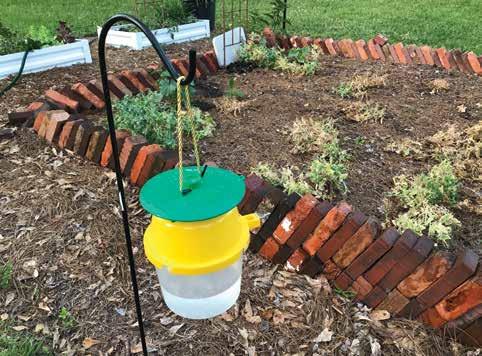
A third method I’ve heard of but also not yet tried is to put a plastic or Styrofoam cup around the stem by cutting along a side of it and then cutting a hole into the bottom of the cup. The cup’s opening will then be flush with the soil.
If you try this or any of these methods and they work for you, or if you have a squash vine borer killing tip for me, I would love to hear about it. We gardeners like to stick together and share our successes … and failures, so we can learn from each other. Please send me a note at melanie@theitem.com.

My first zucchini seedling has already sprouted, and another or two are hopefully on their way through the soil in their recycled seed-starting tray soon. Maybe I won’t let them down this year. Maybe the borers will back off and I’ll get to actually use the summer corn and zucchini chowder recipe I just saved on Pinterest.
Wish me luck, please. And more zucchini than I know what to do with.
This squash vine borer trap includes a pheromone to attract the moths to the trap, and they are drowned in the liquid beneath the lure.










































































